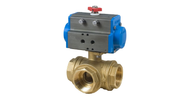Streamline Operations with Pneumatic Actuated Valves
Jan 21st 2025
Is your system running efficiently? Pneumatic actuated valves can help streamline operations by providing precise control and faster response times. These valves use air pressure to control the flow of fluids or gases, making them ideal for a wide range of industrial applications. In this blog, we’ll explore how pneumatic actuated valves can improve the performance of your system. Lehigh Valley Valve is your trusted provider for these reliable valves.
What Are Pneumatic Actuated Valves?
Pneumatic actuated valves use compressed air to control the opening and closing of the valve. They are commonly used in industrial systems to automate processes. By using air pressure instead of electricity or manual force, pneumatic actuated valves are highly efficient and can respond quickly to changes in the system.
Benefits of Pneumatic Actuated Valves
Pneumatic actuated valves offer a variety of benefits that make them a great choice for your system. Here are some key advantages:
- Quick Response: Pneumatic actuated valves open and close quickly, allowing for faster system adjustments and improved control.
- Energy Efficiency: Using compressed air instead of electricity makes pneumatic actuated valves more energy-efficient, reducing your system’s power consumption.
- Simple Design: These valves are easy to install and maintain. Their simple design helps reduce maintenance costs and ensures long-term reliability.
- Cost-Effective: Compared to other types of actuated valves, pneumatic actuated valves are relatively affordable and provide great value for your investment.
- Safety: Pneumatic actuated valves are often more reliable than electric actuated valves in hazardous environments. The lack of electrical components reduces the risk of sparks or fire.
How Pneumatic Actuated Valves Improve System Efficiency
Using pneumatic actuated valves helps improve the efficiency of your system in several ways. First, they offer fast and reliable control over fluid and gas flow, reducing delays in your operations. Their quick response times make them perfect for systems that require high-speed adjustments.
Second, pneumatic actuated valves help reduce the need for manual labor. Since they are automated, these valves minimize human error and improve accuracy. This leads to fewer system errors and downtime, which ultimately increases the overall productivity of your operations.
Lastly, pneumatic actuated valves are energy-efficient, meaning your system can run on less power while still providing high performance. This can help you save on energy costs in the long run.
Why Pneumatic Actuated Valves Are Essential for Your System
Here are some key reasons why pneumatic actuated valves are crucial for your system:
- Precise Control: Pneumatic actuated valves provide accurate flow control, which is vital for maintaining the stability and performance of your system.
- Automation: They automate system processes, reducing the need for manual control and ensuring more consistent operations.
- High Reliability: These valves are known for their durability and reliability, even in demanding conditions.
Why Choose Lehigh Valley Valve?
Lehigh Valley Valve is your go-to provider for pneumatic actuated valves. We offer top-quality products that ensure your system runs smoothly and efficiently. When you choose Lehigh Valley Valve, you benefit from:
- High-Quality Products: We offer only the best pneumatic actuated valves, designed to meet industry standards.
- Expert Guidance: Our experienced team can help you select the right valves for your system’s needs.
- Affordable Solutions: We provide high-quality valves at competitive prices, offering excellent value for your investment.
- Reliable Support: Lehigh Valley Valve is here for you with ongoing support for installation, maintenance, and troubleshooting.
Choose Lehigh Valley Valve for your pneumatic actuated valve needs, and let us help you optimize your system’s efficiency.

